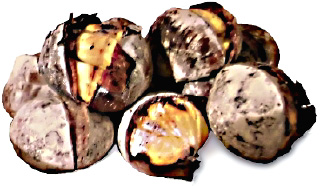...Best of Sicily presents... Best of Sicily Magazine. ... Dedicated to Sicilian art, culture, history, people, places and all things Sicilian. |
by Roberta Gangi | ||
Magazine Index Best of Sicily Arts & Culture Fashion Food & Wine History & Society About Us Travel Faqs Contact Map of Sicily |
In Catania and Palermo you'll see the white smoke wafting into the crisp evening air in busier squares from October through March. Hardly anybody roasts them at home. Chestnuts are regarded as a European food popularized during the Middle Ages. Related to the oak and the beech, the genus castanea is Eurasian and North American. Edible European varieties are of the so-called sweet chestnut (castanea sativa), introduced in antiquity from Asia Minor, probably by prehistoric neolithic farmers. The ancient Greeks and Romans subsequently introduced them over a wider range of cultivation, extending into Britain and northeastern Gaul (France). Its hard wood is highly prized, and chestnut trees seem to live forever. One of the oldest trees in Europe is a chestnut tree in eastern Sicily, the Hundred Horse Chestnut outside Sant'Alfio in the Etna region, estimated to be well over two thousand years old. It is certainly the oldest in Italy, its documented history dating from the fifteenth century, and it also happens to be one of the largest (widest) trees in Europe. However, Italy's principal chestnut-growing region ranges from Mugello in Tuscany northward into Liguria and Piedmont. Almonds and hazelnuts are far more common in Sicilian cuisine nowadays; chestnut flour, formerly popular in making a certain kind of Sicilian bread, is rare in Sicilian cookery. Castagno, Castagnaro, Castagnolo and various Sicilian surnames seem to reflect the profession of "chestnut grower" and it appears that there were far more chestnut trees in Sicily a few centuries ago than there are today. There were also more oaks, though truffles are still found in the Nebrodi region. However, the term castano also refers to the color brown or reddish "chestnut" brown. A chestnut orchard is a castagneto or (in Sicilian) a castagnitu. In the Etna region, not too far from the ancient chestnut tree, is a town called Trecastagni (literally "three chestnut trees") named for the trees that were once abundant there. Chestnuts are rich in various minerals, especially potassium, phosphorus, magnesium and calcium. Unlike most nuts, they contain a substantial quantity of ascorbic acid (Vitamin C). They can, in theory, be eaten raw. Oddly enough, while marrons glacé are considered something of a luxury today, chestnuts were historically viewed as poor food for poor people. That image seems to be changing. About the Author: Roberta Gangi has written numerous articles and one book dealing with Italian cultural and culinary history, and a number of food and wine articles for Best of Sicily Magazine. | |
Top of Page |
 The days can be quite warm
in Sicily well into October, but the first nights of the month are usually
relatively cool, even in the largest cities. That's when you'll begin to see chestnut
vendors roasting the annual harvest of castagne from the
The days can be quite warm
in Sicily well into October, but the first nights of the month are usually
relatively cool, even in the largest cities. That's when you'll begin to see chestnut
vendors roasting the annual harvest of castagne from the